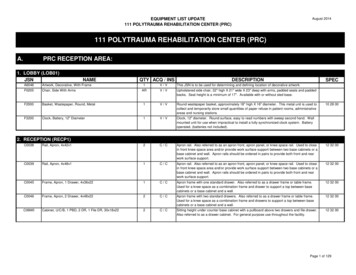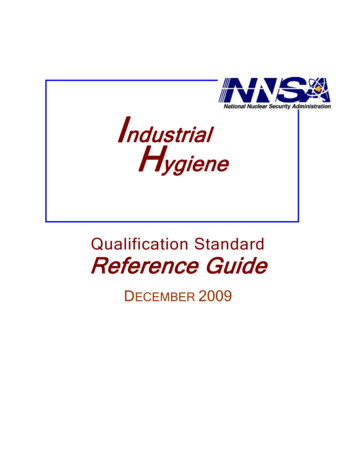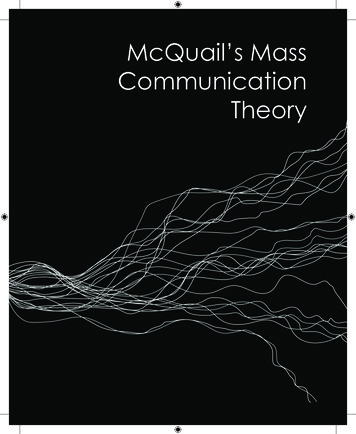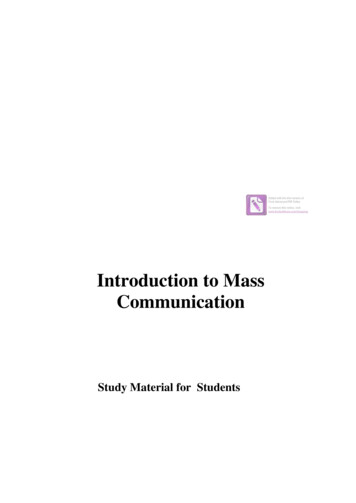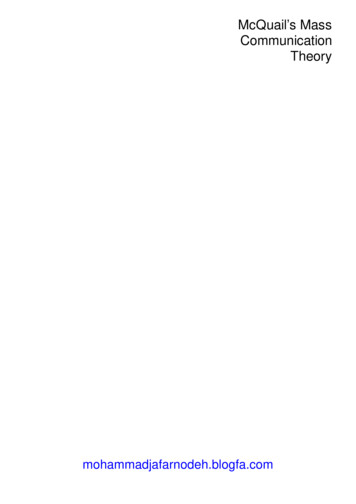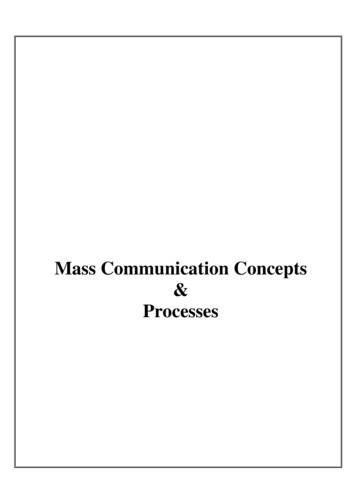
Transcription
Communication Industrial Standard of PRCYD/T 1591-2006Technical Requirement and Test Method ofCharger and Interface for MobileTelecommunication Terminal EquipmentPublished by Dec 14, 2006implemented by Dec 14, 2006Published by Ministry of Information and Industry of PRC
YD/T 1591-2006Table of contentsForeword . ⅡIntroduction. Ⅲ1Scope.12Specification reference document .13Definition and abbreviation.24Technical requirement.35Test method .14References .I
YD/T 1591-2006ForewordThis standard is prepared referring to the following standards:1. GB4943-2001 Security of Information Technical Equipment2. YD 1268.2-2003 Security Requirement and Test Method of Lithium Battery Charger for theMobile Communication Terminal3. GB9254 Wireless Interference Limit and Measure Method of Information Technical Equipment4. GB17465.1 Housing and Similar Appliance Coupler Part I: Universal Requirement5. GB 17625.1 Magnetic Compatibility Limit Emission Limit for Harmonic Current6. GB 17625.2 Magnetic Compatibility LimitLimit for the Voltage Fluctuation Generated bythe Equipment with the Rated Current Less than 16A in the Low-Voltage Supply System.When the charger simultaneously works with the mobile communication terminal, its magneticcompatibility feature should respectively meet the magnetic compatibility requirement of themobile communication terminal in different modes. Meanwhile, during the preparing process ofthe standard, it also refers to the electric feature and mechanical structure of “universal serial busspecification (version 2.0)” interface.With the development of the technology, the related standards will be continually prepared. Afterthis standard is issued, we will conduct researches on the technical requirement and test methodsof the equipment such as on-board DC charger and plan to supplement the corresponding partsas the supplementary documents of this standard if necessary.This standard is proposed and managed by China Communication Standardization association.Drafted by: Telecom Research Institute of Ministry of Information and IndustryKonka Group Co., LtdKey drafters: Liu Jun, Men Meng, Yuan Weijun, Yuan Yuan, Zhang Xia, He Guili, Li Hongtao,Du YongII
YD/T 1591-2006IntroductionThis standard is prepared to guarantee the security of the product and availability, meanwhile, itenables the mobile communication terminals with different types to use the charger having the samespecification to reduce the electronic waste, protect the environment, save resource and reduce theuse cost of the mobile communication terminal through the uniform interface mode and technicalrequirement.Considering the requirement for the data exchange between the mobile communication terminal andperipheral equipment and sharing possibility of the charging cable, this standard refers to the A seriesinterface specification of the Universal Serial Bus (USB) to improve the application efficiency andconvenience of the related components.Considering the individual development of the mobile communication terminal, this standardregulates the uniform connection interface and sets it on the charger side, and the connectioninterface on the mobile communication terminal side is identified by the designer and manufacturerof the products.III
YD/T 1591-2006Technical Requirement and Test Method of Charger and Interface forThe Mobile Communication Terminal1ScopeThis standard regulates the technical requirement and test method of charger and interface ofthe mobile communication terminal (hereafter called as the “terminal”), including the physicalfeature, electric feature, security feature, magnetic compatibility and environment adaptabilityof the AC charger and interface.This standard is applicable to the interface of the terminal charger, AC charger and connectioncable.2Specification reference documentThe articles in the following document become the articles of this standard through thereference of this reference. For any reference document with the date, its subsequent modifiedcontents (not including corrected content) or revisal versions are not applicable to thisstandard, however, it is encouraged that all parties reaching this agreement on this standardstudy whether the latest versions of these documents can be used. For any reference fileswithout the date, its latest version is not applicable to this standard.GB 2099.1-1996 Housing and Similar Plug and Socket Part I: Universal RequirementGB 4943-2001Security of Information Technical EquipmentGB 5023.5-1997 Insulation Cable Polythene below the Rated Voltage 450/750V Part V:Software Cable (chord)GB9254Wireless Interference Limit and Measure Method of the InformationTechnology EquipmentGB 17465.1-1998 Housing and Similar Appliance Coupler Part I Universal RequirementGB 17625.1Magnetic compatibility Limit Emission Limit for Harmonic WaveCurrentGB 17625.2Magnetic compatibility Limit Limit for the Voltage Fluctuation andFlickering Generated by the Equipment with the Rated Current less than16A in the Low-Voltage Supply SystemGB/T gyAnti-Interference Test for Static DischargingGB/T gyAnti-Interference Test for Electric Quick and Instantaneous Pulse ClusterGB/T 17626.5Magnetic Compatibility Test and Measure Technology Surge (impact)Anti-Interference TestYD 1268.2-2003 Security Requirement and Test Method of the Lithium Charger for theMobile Communication Terminal1
YD/T 1591-2006ISO 7637-2:20043Vehicle Electric Interference of Conduction and Coupling Part II:Instantaneous Conduction along the LineDefinitions and abbreviationsThe following definitions and abbreviation are proper for the standard.3.1Definition3.1.1Connection plugThe connection cable terminal and connection plug with the charger3.1.2Connection socket-outletThe socket of the charger with the connection cable3.1.3Direct plug-in chargerThe AC power plug and shell of the charger are composed of a whole and its weight issupported by the socket on the wall.3.1.4Class II equipmentThe shock-resistance not only protects the basic insulation, but also adopts the equipmentwith the attached security protection measure. This type of equipment does not depend onthe protection grounding and protection measure of the installation environment.3.1.5Class V-0 materialTested by the GB 4943-2001 appendix A, this material can combust or scorch, but theaverage duration does not exceed 5s, the released scorching particle or combustion dropupon combustion does not lead to the combustion of the absorbent cotton.3.1.6Class V-1 materialTested by the GB 4943-2001 appendix A, this material can combust or scorch, but theaverage duration does not exceed 25s, the released scorching particle or combustion dropupon combustion does not lead to the combustion of the absorbent cotton.3.1.7Connection mode with AC power3.1.7.1Detachable power supply cordThe cord using the proper appliance connection to connect with the charger and used forpower supply3.1.7.2Non-detachable power supply cordThe cord fixed on the charger or installed with the charger for power supply3.1.7.3The side of mobile telecommunication terminalGenerally it indicates the mobile communication terminal connection cable and plugconnected to the DC output plug of the charger3.1.7.4The side of chargerGenerally it indicates the plug connecting with the charger and DC output.3.2AbbreviationUSB universal serial busPVC polyvinyl chlorideVBus voltage busGND groundAWG American wire gaugeSTC stranded Tin copper2
YD/T 1591-200644.1Technical requirementConnection structureThe interface of the terminal and charger involved in this standard is set on the charger sideand is defined by the mechanical fitting between the plug and socket and electricperformance; the charger is connected to the terminal on another side through the connectioncable to realize the charger function. The interface between the terminal and connectioncable is designed by the designer, as shown in the figure 1 and figure 2.Charger sideConnector socket(refer to USB A series)Designed by thedesignerConnector socket(refer to USB A series)Side of the mobile communication terminalFigure 1Illustration I for connection structureCharger sideChargerMobile communicationterminalConnector socket(refer to USB A series)Designed by the designerConnector socket(refer to USB A series)Side of the mobile communication terminal4.24.2.1Figure 2 Illustration II for connection structureConnection interfaceMechanical structure of the connection interfaceThe connection interface adopts the connection plug and socket of the universal serial businterface shown in the figure 3 and figure 4 (refer to USB A series).3
YD/T 1591-2006(typical value)(typical value)Contact of the socketPrinted circuitboardContactCentral lineNote:1)All sizes use the mm as the unit.2) For the surface and plug of the socket, theallowed minimum space between theprotection cover of secondary plasticinjection forming is 2.67 mm.Figure 34Structure and size of the connection plug (USA A series)
YD/T 1591-2006typical valuetypical valuetypical valuetypical valueContact of theplugUL94-VO plug external coverCentral lineCentralProtectioncover of onceplastic injectionlineProtection coverof once plasticinjection formingGold-plating area4.2.24.2.2.14.2.2.24.2.34.2.3.1Note:1) All sizes use the mm as the unit.2) The total length of the connector and cablecomponent is the distance from base point ofthe A series plug to the base point of the Bseries plug or to rough terminal.Figure 4 Structure and size of the connection plug (refer to USB A series) IIReliability requirement of the connection interfaceInsertion force and pulling forceThe plugging is allowed between the plug and socket, when the speed of the plug doesnot exceed 12.5 mm/min, maximum force for inserting fully the plug into the socket cannot exceed 35N and the required force for pulling the plug from the socket can not be lessthan 10N.Plug lifetimePlug in/plug out for 15000 periods at the maximum speed during the 200 periods of onehour, after the plugging ends, the mechanical structure should not be damaged. Therequired minimum force for pulling the connection plug out from the socket is not lessthan 8N, the electric performance should meet the requirement in the 4.2.3.Electric performance of the connection interfaceElectric performance requirement of the connection interface on the terminal side(1)The DC input voltage of the terminal charging interface is 5V(1 5%): maximum5
YD/T 1591-20064.2.3.2absorption current is 1800mA. Regardless of the input power of the charger, thecharging control circuit on the terminal side should be securely charged accordingto self requirement and the phenomena such as the over heating, combustion,explosion and other circuit damage should not occur.(2) The charging control circuit on the terminal side should include the voltage limitprotection set. when the charging interface of the terminal is imported by over 6Vvoltage, if the secure charging can not be guaranteed, the charging control circuiton the terminal side should securely charge according to self requirement, thephenomena such as the over heating, combustion, explosion and other circuitdamage should not occur.(3) When the connecting power supply set is not standard regulated charger (such asthe built-in USB A series interface of the computer or portable computer).(4) Considering that absorption current’s security to the power supply set when theterminal is charging which has been produced and sold before this standard isimplemented, the designer should carefully consider whether the sold terminalsmeet the secure charging measure regulated in the standard, when this standard isadopted, the physical design of the interface between the terminal and connectioncable different from old design should be used, or the connection cable should beinstalled by the recognition and current limit set to prevent the user from riskgenerated upon mistaken operation.Interface requirement of the charger side(1) USB (refer to USB A series) on the charger side is shown as the figure 5,whereVBus is the anode pole of the output DC power, GND is the output DC power’scathode pole (ground). D and D- should be short-circuit and does not connect toany part of the charger inside the charger. As a specific connection, it can enable tothe terminal to recognize that the connected USB (refer to USB A series) is chargerset defined in this standard.PowerChargerInput end4.2.3.3Figure 5 Short circuit from D to D- in the charger(2) Outputted voltage of the charger is 5V; the output current range is 300-1800mA.The charger product should mark the detailed rated output voltage and current.Insulation resistanceThe insulation resistance of the connection interface should not be lower than 1000MΩ.4.2.3.46Voltage resistance of the insulation materialThe insulation material of the connection interface should support the val
Communication Industrial Standard of PRC YD/T 1591-2006 Technical Requirement and Test Method of Charger and Interface for Mobile Telecommunication Terminal Equipment Published by Dec 14, 2006 implemented by Dec 14, 2006 Published by Ministry of Information and Industry of PRC . YD/T 1591-2006 I Table of contents Foreword. Ⅱ Introduction.Ⅲ 1 Scope.1 2 Specification reference .



